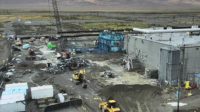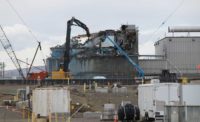After manufacturing plutonium for U.S. atomic weapons from 1949 to 1989 and 20 years of cleanup prep and phased demolition, the Plutonium Finishing Plant at the U.S. Energy Dept.’s Hanford nuclear waste site in Washington state—a complex of 90 structures that is one of the site’s most toxic areas—was reduced to rubble last month.
Crews from CH2M, a key site environmental contractor that was acquired by Jacobs in 2017, finished demolition of the complex's highly contaminated building 234-5Z last month.
The $1.2-billion cleanup program of the complex, which included $170 million to remove four anchor buildings and involved decommissioning and cleanup of about 200 pieces of plutonium manufacturing equipment and process lines, as well as 1.5 miles of ventilation piping, comes as the Trump Administration proposes to cut Hanford's cleanup budget by some $700 million in the proposed fiscal 2021 federal budget.
Demolition work began in 2016 of the complex, which formerly produced plutonium components for shipment to atomic weaponmaking plants across the U.S.
Following a spread of radioactive contaminants to other parts of the Hanford site from rubble left at the plant's reclamation facility in 2017, all worked stopped. Jason Casper, vice president of the PFP Closure Project for CH2M Hill Plateau Remediation Co., says crews enacted nine major technical additions to ensure there was no more spreadt another spread of contamination.
Those included applying water more liberally, a more frequent use of fixatives, expanding the area’s boundaries for a larger workspace, an independent hazard review board validating each phase of work, mock-ups prior to new phases starting and an updated monitoring system with real-time capabilities.
Work restarted in 2018 but not at the most contaminated part of the structure until 2019. “Since we restarted,” Casper says, “we haven’t had any spreads.”
The toughest part of the plant demolition centered around the highly contaminated process lines. With two bulding levels above them and multiple structures surrounding them, crews used a high-reach processor jaw, “basically large scissors to snip beams and pull them off without dropping on the lines," he says.
Tom Teynor, DOE project director, says an independent structural engineer helped devise a process to bring the building down in a controlled manner.
“We didn’t want to have a piece of I-beam or equipment fall into and possibly breach the walls or ceiling" of the process lines, he says. Crews attached an exhauster unit to capture contamination.
Final activities on site include packaging and safe disposal of demolition rubble, core sampling soil beneath the building pads, and stabilization of the site with soil cover.
The plutonium contamination easily adheres to the soil. “It has proven to be a good technique,” Casper says, “to make sure the contamination stays at the demolition point.”
Work is scheduled for a summer completion.
Unclear and budget dependent, however, is how and when site managers will address remaining underground structures at the plant site, according to a Tri-City Herald report.






